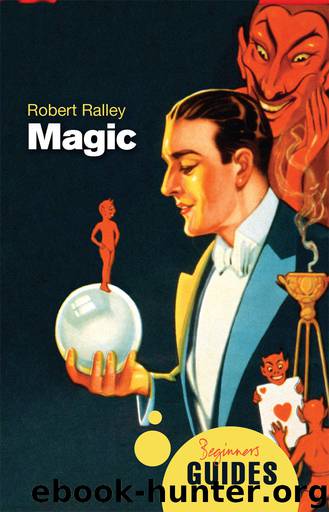Magic by Robert Ralley

Author:Robert Ralley [Ralley, Robert]
Language: eng
Format: epub
ISBN: 9781780741666
Publisher: Oneworld Publications
Rationalist magicians
Through the nineteenth century and beyond, magical performers of all kinds declared their continuing commitment to the rationalist project of uncovering the deception used by those who falsely claimed real magical and religious phenomena. One illusionist, William Pinchbeck, explained that his writing was ‘not only to amuse and instruct, but also to convince superstition of her many ridiculous errors’. Superstitions were ‘dangerous ... to society’ and ‘ruinous to the common interests of mankind.’ P. T. Barnum (1810–91) wrote admiringly of a magician with whom he had toured the Southern States. This man had ‘astonished his auditors with his deceptions’, then later showed ‘how each trick was performed, and how every man might thus become his own magician’. Barnum himself played throughout his career on the relationship between credulity and scepticism; he achieved renewed interest in a show he was running in the mid-1830s by claiming anonymously in a newspaper that its exhibit, Joice Heth, supposedly the 161-year-old nurse of George Washington, was actually an automaton voiced by a ventriloquist.
By the later nineteenth century, the key target for magicians’ rationalist ire was spiritualism; psychical researchers investigating spiritualist phenomena tended to seek help from expert illusionists. Much attention through the middle years of the century focused on the American spiritual mediums Ira and William Davenport, who toured the world with a show that included phenomena such as banging noises and musical instruments being played in darkened rooms while the mediums were apparently tied up. Both the French performer Robert-Houdin and the Scottish magician John Henry Anderson denounced the Davenports, while P. T. Barnum called them ‘impostors’ and explained that he felt it was his duty to expose them because they were dishonest in their trickery. In 1909 a retired Ira Davenport (1839–1911) was visited by Houdini, who apparently listened to the medium’s confession.
Houdini remained publicly silent on this meeting for over a decade; but through the 1920s, after his mother’s death, he gained a reputation for exposing fraudulent spirit mediums. He attended séances, eventually disguising himself and bringing a reporter and a police officer in tow. In 1924 he revealed a Boston medium known as ‘Margery’ (real name Mina Crandon) to be a fraud; from 1923 he was also a member of a Scientific American committee offering a cash prize to any medium able to demonstrate psychic abilities. Famously, Houdini’s activities in this area caused a rift with Sir Arthur Conan Doyle, who spent his latter years seeking truth in the Spiritualism that Houdini so strongly criticized. Doyle concluded that Houdini was himself a powerful spirit medium who had used his abilities during his stage career and was now employing them to thwart the performers he claimed to be exposing as frauds.
The English illusionist J. N. Maskelyne, who became one of England’s foremost opponents of spiritualism, began his career by confronting the Davenports. He had served an apprenticeship as a watchmaker, but his amateur interest in conjuring saw him selected to attend a séance at Cheltenham Town Hall in 1865 in order to test the Davenports’ claims.
Download
This site does not store any files on its server. We only index and link to content provided by other sites. Please contact the content providers to delete copyright contents if any and email us, we'll remove relevant links or contents immediately.
Harry Potter and the Cursed Child: The Journey by Harry Potter Theatrical Productions(3966)
The Sports Rules Book by Human Kinetics(3588)
Molly's Game: From Hollywood's Elite to Wall Street's Billionaire Boys Club, My High-Stakes Adventure in the World of Underground Poker by Molly Bloom(2968)
A Knight of the Seven Kingdoms by George R R Martin(2623)
Quidditch Through the Ages by J.K. Rowling(2578)
Quidditch Through the Ages by J K Rowling & Kennilworthy Whisp(2566)
How To by Randall Munroe(2476)
Quidditch Through the Ages by Kennilworthy Whisp by J.K. Rowling(2415)
Quidditch through the Ages by J. K. Rowling(2361)
Quidditch Through The Ages by J. K. Rowling(2323)
Stacked Decks by The Rotenberg Collection(2270)
776 Stupidest Things Ever Said by Ross Petras(2268)
The Infinite Retina by Robert Scoble Irena Cronin(2181)
What If?: Serious Scientific Answers to Absurd Hypothetical Questions by Randall Munroe(2170)
Flowers For Algernon by Daniel Keyes(2159)
Beautiful Oblivion by Jamie McGuire(2145)
The Book of Questions: Revised and Updated by Gregory Stock Ph.d(2139)
Champions of Illusion by Susana Martinez-Conde & Stephen Macknik(2077)
Ready Player One: A Novel by Ernest Cline(2076)
